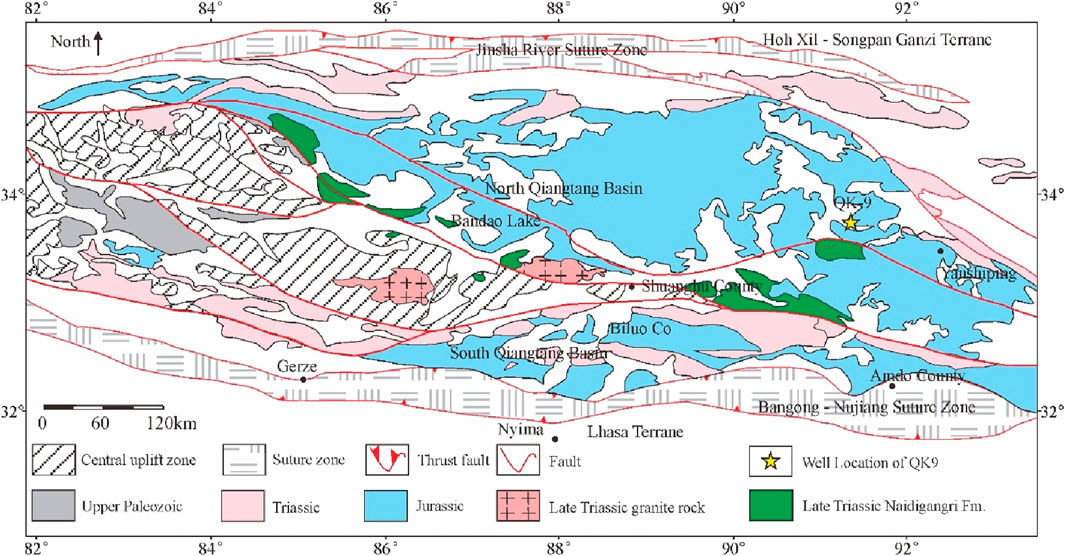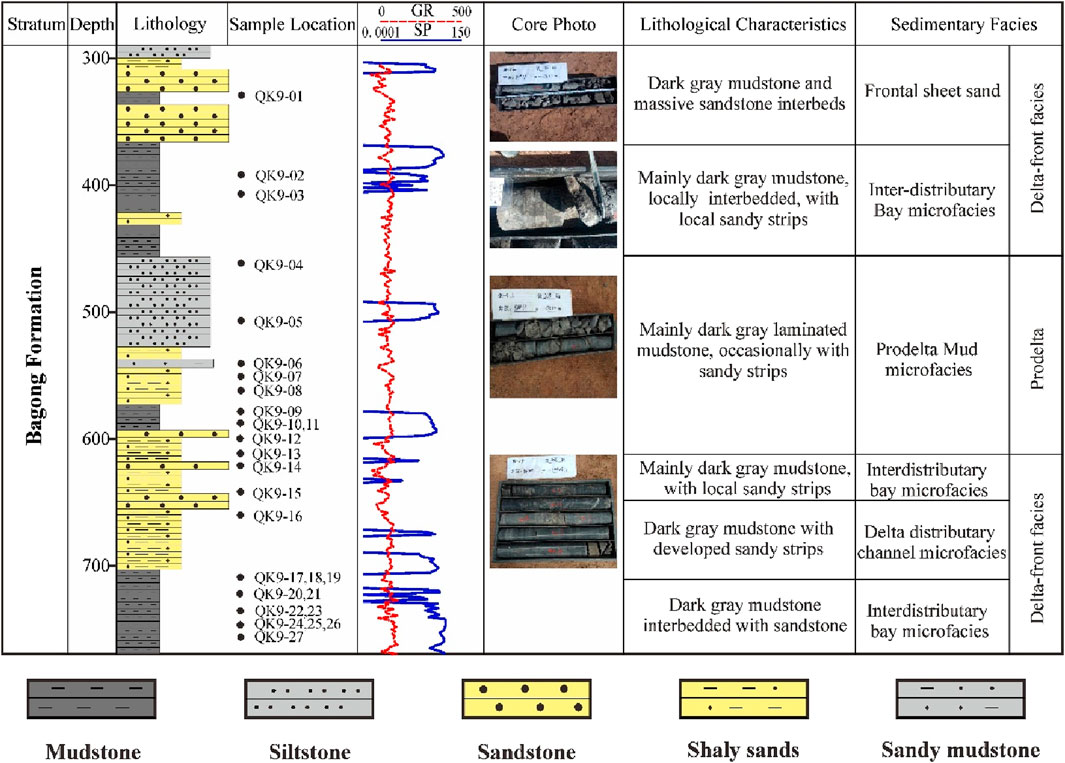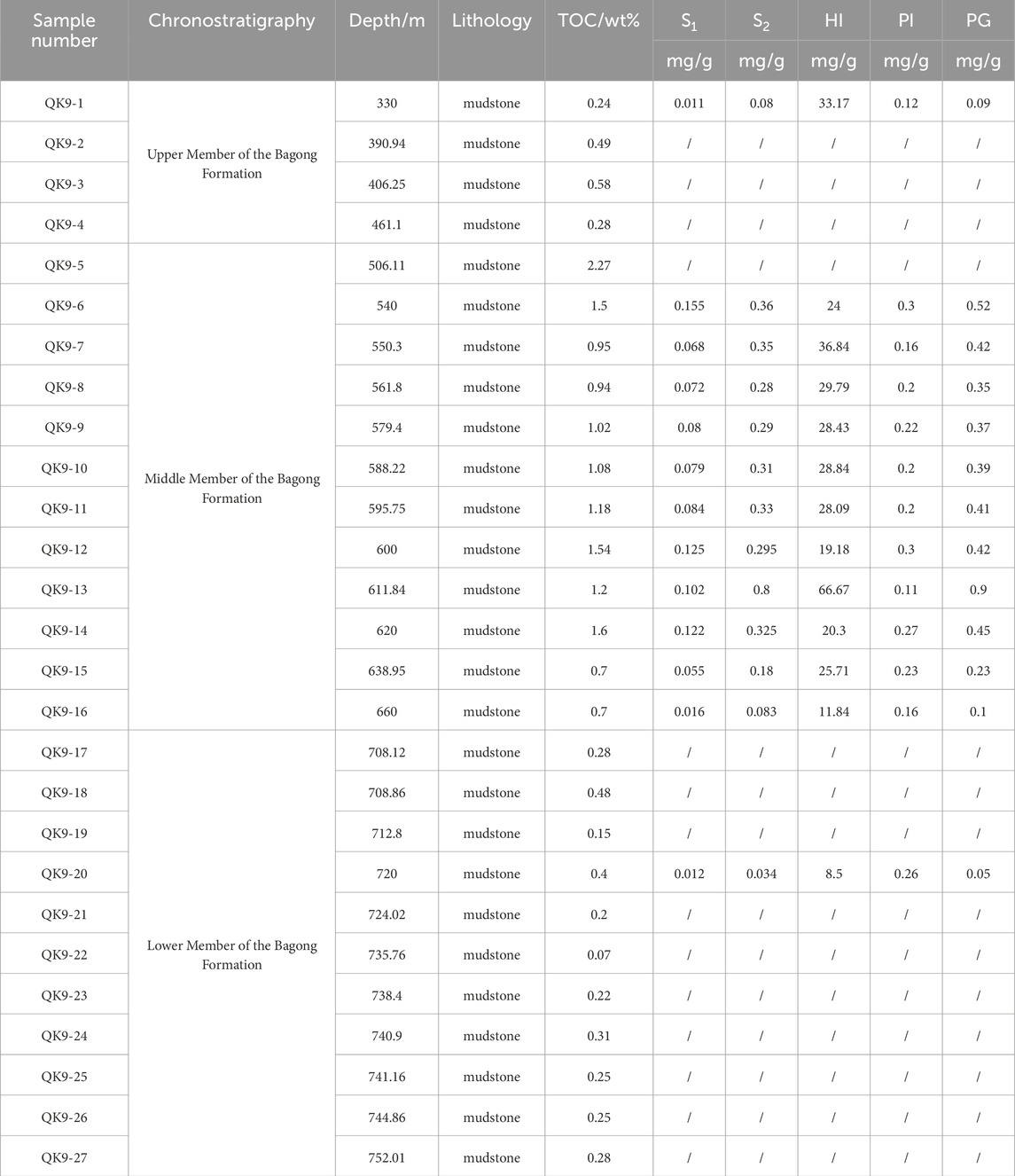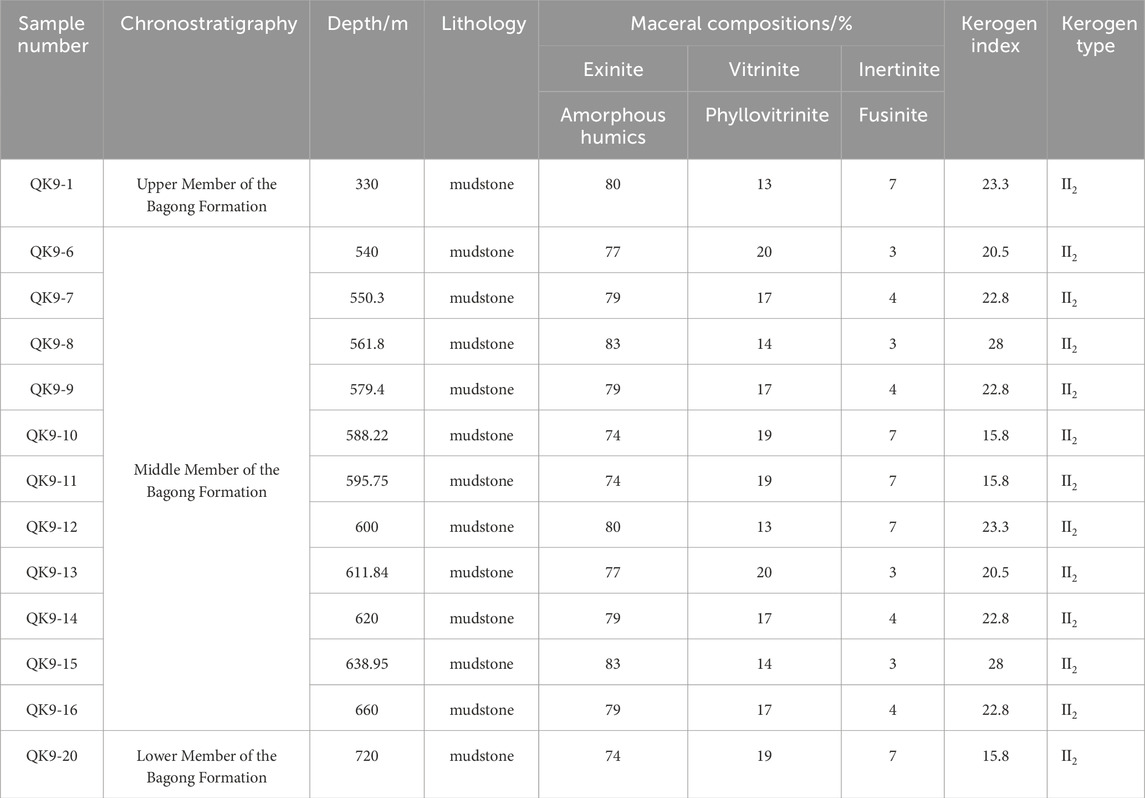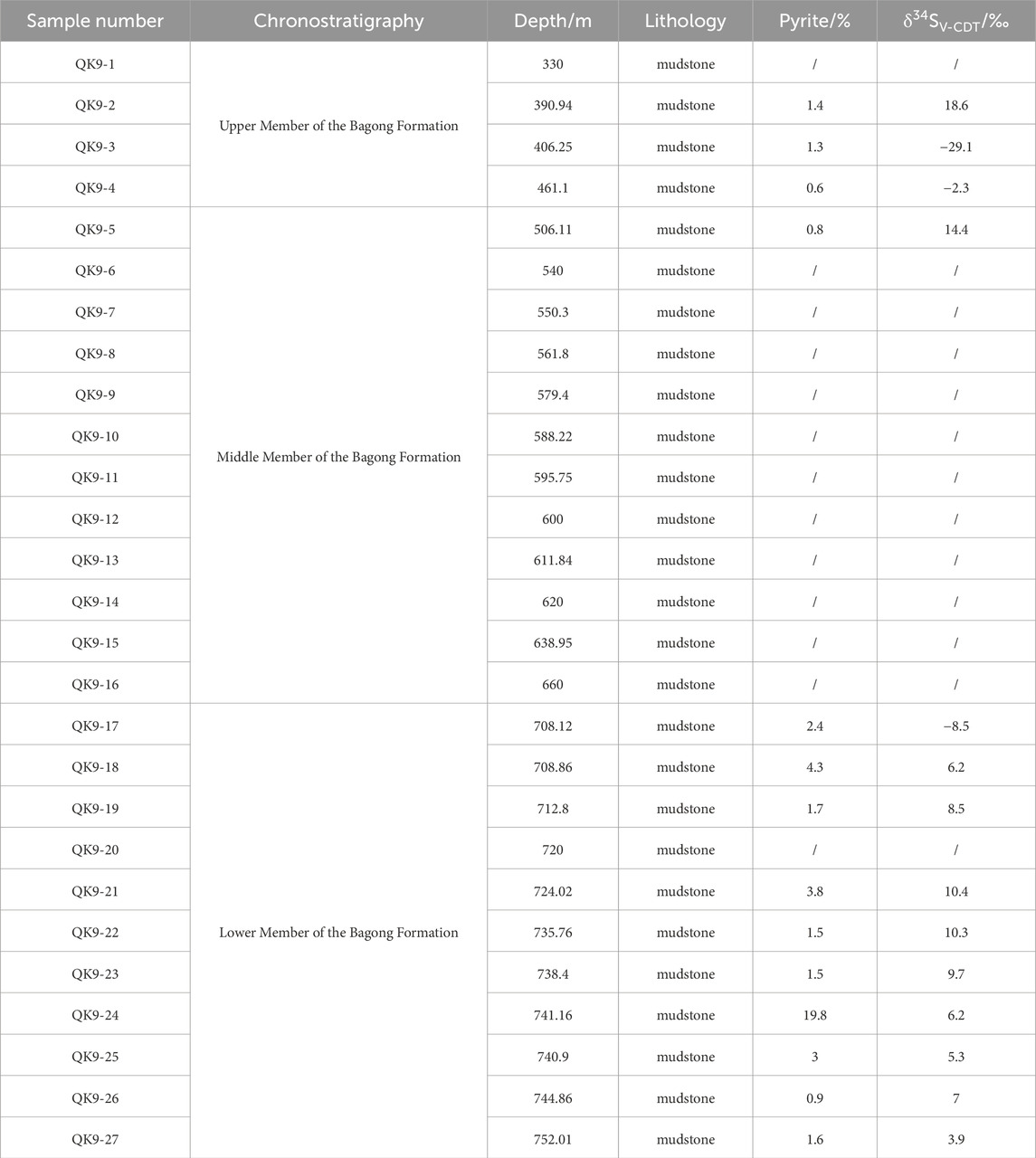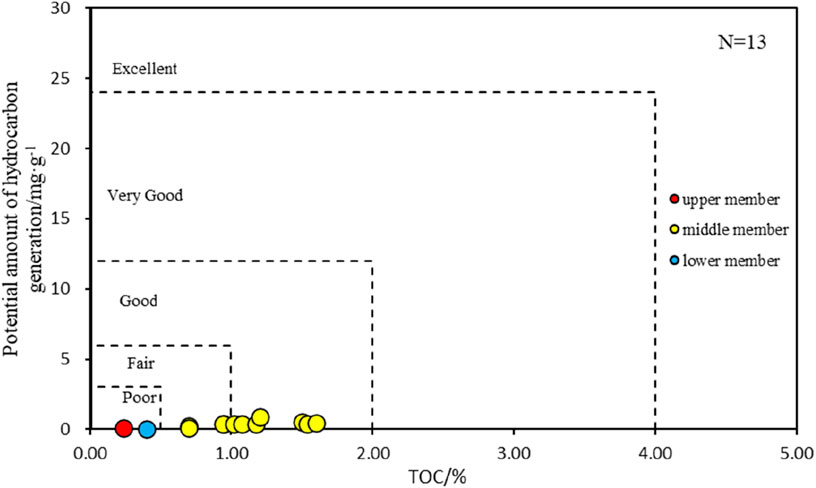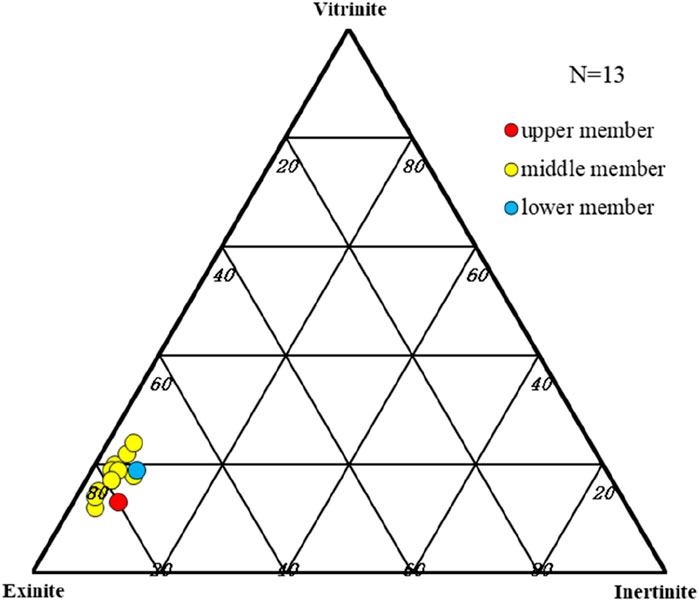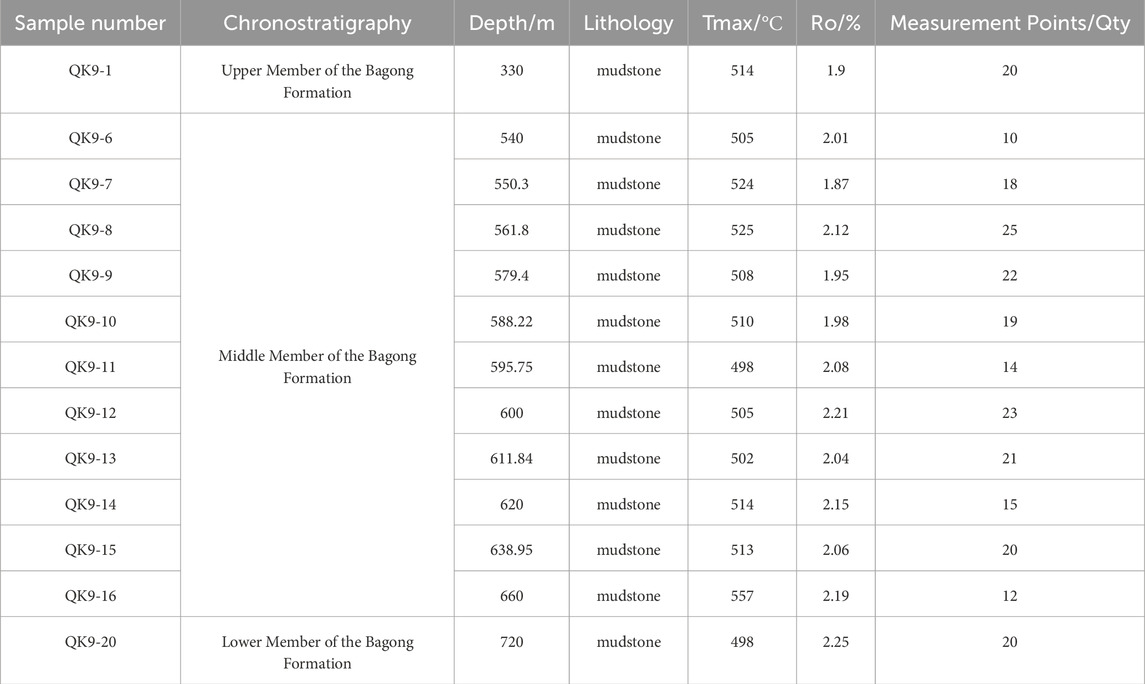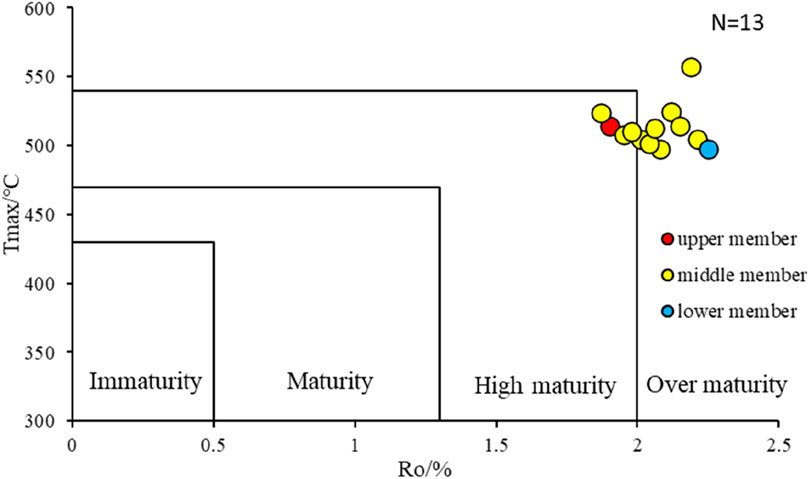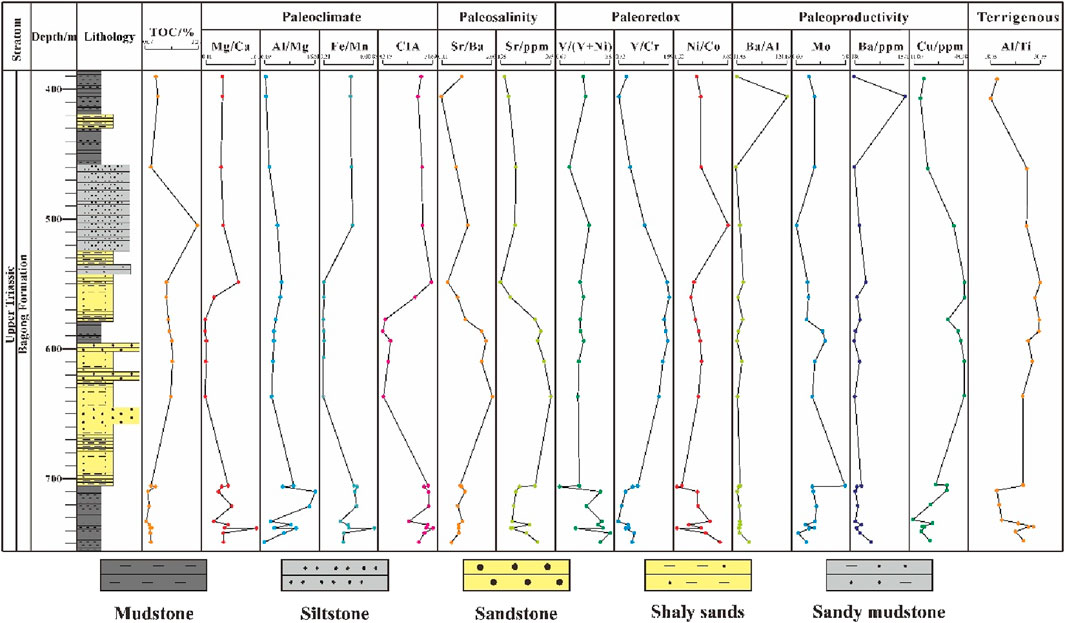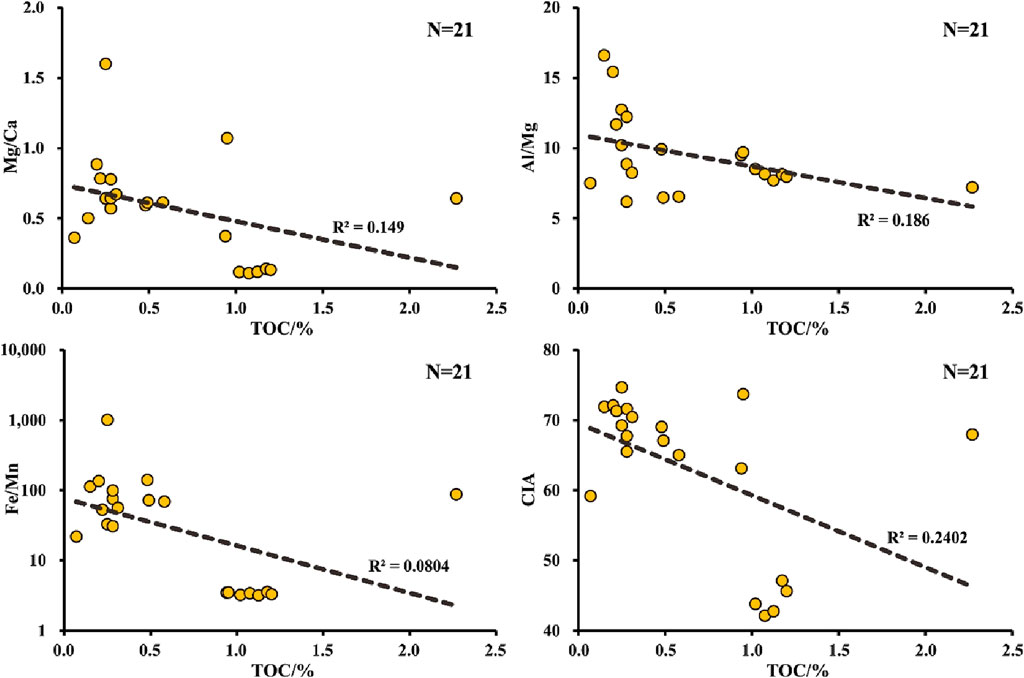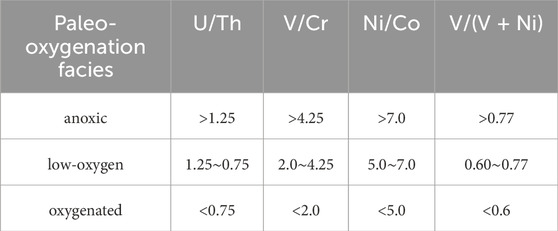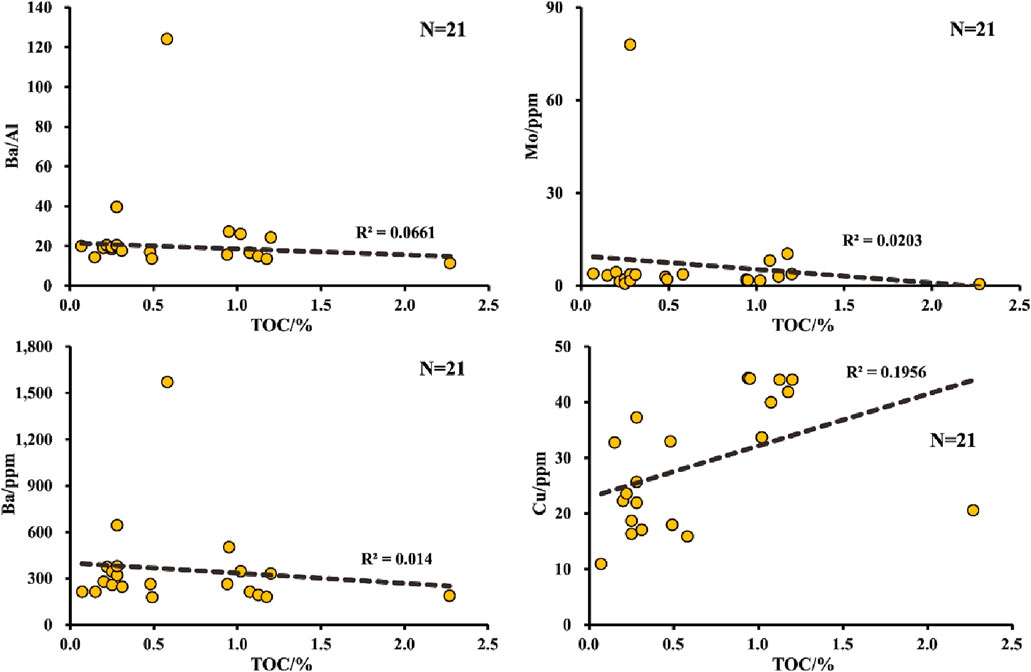- 1 Oil and Gas Survey, China Geological Survey, Beijing, China
- 2 Beijing Research Institute of Uranium Geology, Beijing, China
The Upper Triassic of the Qiangtang Basin is a key strata for oil and gas exploration in the Qinghai-Tibet Plateau. However, it has been controversial argued about the paleoenvironmental control mechanisms for the development of its source rocks. Based on the core samples from Well QK-9, this study reveals the climate and salinity on organic matter accumulation through comprehensive analysis of both organic geochemistry (TOC, Rock-Eval pyrolysis) and inorganic geochemistry (major and trace elements, pyrite content and isotopes). The results are: (1) The middle section consists of relatively good source rocks with relative high TOC (TOC = 0.70%–2.27%, with an average of 1.22%), while the upper and lower sections are poor source rocks for the low TOC (TOC = 0.07%–0.58%, with an average of 0.30%). (2) Paleoclimate (transitioning from humid to arid and back to humid) and paleosalinity (shifting from low to high and then to low) are the primary factors contributing to the vertical differentiation of source rocks. In contrast, the influence of oxidation conditions and biological productivity during that period was relatively minor. (3) In the upper and lower parts of the Bagong Formation, the accumulation of pyrite (with an average of 3.2%) is negatively correlated with low TOC (<0.3%), indicating that the sulfate-reducing bacteria (BSR) exacerbate the degradation of organic matter in a reducing environment. In the middle section, pyrite is less and the TOC increases significantly (with an average of 1.22%). This study reveals the negative correlation between pyrite accumulation and low TOC, challenging the traditional understanding that “reducing environments favor source rock formation” and proposing a “climate-salinity coupling” model for organic matter accumulation as a new theoretical basis for the evaluation of marine source rocks and oil and gas exploration in the complex tectonic background of the plateau.
1 Introduction
The Qiangtang Basin, situated in the oil-prone eastern Tethyan tectonic domain, represents China’s largest Mesozoic marine petroliferous basin with the most complete stratigraphic succession and least explored onshore hydrocarbon potential, possessing geological prerequisites for developing large to supergiant hydrocarbon accumulations (Wang et al., 2001; Wang C. et al., 2004; Wang J. et al., 2004; Wang et al., 2009; Wu et al., 2020; Chen et al., 2024). Early exploration primarily targeted Jurassic strata, though intense Cenozoic tectonic activity has extensively exposed these formations through multiple uplift events, significantly compromising hydrocarbon preservation conditions and hindering exploration breakthroughs (Liu et al., 2022). Recent strategic shifts have focused on deeper Upper Triassic sequences, where drilling in the Quemocuo area of the eastern Qiangtang Depression encountered substantial hydrocarbon shows and high-quality source rocks, confirming considerable hydrocarbon potential in the Upper Triassic (Zeng et al., 2013; Wu et al., 2021; Wu et al., 2022; Wu et al., 2023; Shen et al., 2023). The persistent efforts of multiple generations of geologists have resulted in the identification of approximately 250 hydrocarbon shows within the Triassic and Jurassic systems of the Qiangtang Basin (Wang et al., 2020). Due to the generally greater burial depths of Triassic strata, initial exploration efforts primarily targeted Jurassic sequences. The QC-1 well drilled during 2016–2018 penetrated Jurassic formations but failed to encounter high-quality Jurassic source rocks, leaving unresolved the critical debate regarding whether the Jurassic or Triassic systems contain the basin’s predominant hydrocarbon source rocks (Ullah et al., 2022; Han et al., 2023; Wang et al., 2023; Ullah et al., 2023). Intense Cenozoic tectonic activity has induced extensive Jurassic exposure through multiple uplift events, severely compromising hydrocarbon preservation conditions (Ashraf et al., 2024; Qinghe et al., 2024; Falak et al., 2024). This structural overprint has fundamentally constrained exploration progress in the Qiangtang Basin (Umar et al., 2024; Qinghe et al., 2025; Yin et al., 2025).
The Upper Triassic Bagong Formation in eastern Qiangtang has been extensively studied regarding the geochemical characteristics and hydrocarbon generation mechanisms of its black shales. Previous works demonstrate that these widely distributed, thick organic-rich mudstones constitute a critical source rock system in the basin (Zhu et al., 2007; Nan et al., 2008; Wang et al., 2012; Chen et al., 2012; Wang et al., 2018; Song et al., 2018; Zhong and Wen, 2020; Tan et al., 2020; Fu et al., 2020; Wang et al., 2022). However, knowledge gaps persist regarding lithofacies classification, sedimentary processes, evolutionary patterns, and genetic mechanisms - particularly concerning paleoclimate controls, paleoproductivity influences, and redox condition effects on source rock development.
Disparate understandings of organic-rich shale distribution patterns, hydrocarbon generation potential, and controlling factors in the Bagong Formation have constrained resource assessments and exploration targeting in northern Qiangtang. The recently completed QK9 well by China Geological Survey in northeastern Quemocuo provides crucial subsurface data and natural laboratory samples for addressing these knowledge gaps. This study focuses on dark mudstones and shales from the Bagong Formation in Well QK9, conducting integrated investigations of organic petrological characteristics, elemental geochemical signatures, and stable isotopic compositions. By employing a combined organic-inorganic analytical approach, we systematically evaluate source rock potential, delineate spatial distribution patterns, identify key controlling factors, and ultimately elucidate the genetic mechanisms and distribution regularities of Upper Triassic hydrocarbon source rocks in the eastern North Qiangtang. These findings provide critical supplementary data and scientific insights to advance hydrocarbon exploration strategies in the Qiangtang Basin.
2 Regional geologic and stratigraphic settings
The Qiangtang Basin, located in the northern Tibetan Plateau, is bordered by the Bangong-Nujiang Suture Zone to the south and the Xijinwulan-Jinsha River Suture Zone to the north (Figure 1). Based on sedimentary filling characteristics and geophysical data, the basin is subdivided into three first-order tectonic units from north to south: the North Qiangtang Depression, the Central Uplift Belt, and the South Qiangtang Depression (Wang et al., 2001; Liu et al., 2001; Yong et al., 2003; Wang J. et al., 2004; Liu et al., 2005; Wang et al., 2009; Lu et al., 2013; Liu et al., 2016; Wang and Fu, 2018). The closure of the Paleo-Tethys Ocean, marked by the present-day Xijinwulan-Jinsha River Suture Zone, occurred during the Late Triassic and played a crucial role in shaping the formation and evolution of the Triassic foreland basin in the North Qiangtang Depression (Wang et al., 2001; Yong et al., 2003; Wang et al., 2012; Zhong and Wen, 2020). During the Late Triassic, the North Qiangtang Depression was sequentially filled by the Upper Triassic Jiapila Formation, Bolila Formation, and Bagong Formation in ascending stratigraphic order, with the most comprehensive and typical exposures located along its eastern margin (Wang et al., 2012).
Well QK-9, located in the Quemocuo area of the eastern Qiangtang Basin, occupies a structural position on the Bozanglongba Anticline. Drilling data revealed that the Bagong Formation, 524 m in thickness, displays conformable contacts with both the underlying Bolila Formation and the overlying Erlongba Formation (Figure 2). The Bagong Formation is subdivided into three members in ascending stratigraphic order: Lower Member (680–768 m), Middle Member (500–680 m), Upper Member (245–500 m).
3 Sample collection and analysis
In this study, a total of 27 mudstone samples were obtained from the Bagong Formation. A comprehensive array of analytical techniques was employed, encompassing Total Organic Carbon (TOC) determination, rock pyrolysis analysis, kerogen maceral identification through microscopic examination, vitrinite reflectance measurements, major and trace element assays, whole-rock X-ray Diffraction (XRD) analysis, Scanning Electron Microscope (SEM) observations, and sulfur isotope analysis.
TOC was analysed by LECO CS 400 carbon and sulphur analyser, after the pretreatment, the sample is weighed and put into the porcelain crucible, in which the iron filings flux ranging from 0.6 g to 1 g and tungsten particle flux ranging from 0.8 g to 1.5 g, input the sample quality on the instrument, and put the porcelain crucible into the instrument for determination. The rock pyrolysis analysis was conducted using the Rock-Eval Ⅵ instrument, employing the widely utilized Bulk-Rock method prevalent in the industry. This method entails an isothermal pyrolysis stage at 300°C for a duration of 3 minutes, followed by a temperature ramp of 25°C per minute until reaching 650°C.
The major elements (Si Al Fe Mg Ca Na K Mn Ti P) were analyzed using X-ray fluorescence (XRF, PW2404). The samples were preheated to 1,000°C for 90 min, and the weight loss was recorded. Later, the ashed samples were mixed with 8-fold lithium tetraborate (Li2B4O7) and fused into glass beads. The analytical precision of the major element data is 1%–5%. For trace elemental analysis, 50 mg powder sample (<200 mesh) was dissolved in a Teflon bomb using 0.5 mL HNO3 and 1 mL HF at a constant temperature (185°C) for 24 h to dry. The dried powder was then treated with 0.5 mL HNO3. The powder sample was acidified twice and then treated using 5 mL HNO3 at a constant temperature (130°C) for 3 h. The dissolved sample in PET bottle was diluted to 50 mL for further analysis by inductively coupled plasma mass spectrometer (HR-ICP-MS; Finnigan MAT). The analytical precision of the major and trace elements was all better than 5%.
High-resolution micro-morphological observations and micro-area analyses of the rock samples were conducted using the FEI Nova Nano SEM450, a high-resolution field emission scanning electron microscope. The secondary electron (SE) image resolution specifications are as follows: 1.0 nm at 15 kV and 1.4 nm at 1 kV in high vacuum mode; 1.5 nm at 30 kV in low vacuum mode. The backscattered electron (BSE) image resolution is 1.5 nm at 30 kV and 3.5 nm at 100 V. The magnification range is from 20 to 1,000,000 times, with a continuously adjustable electron beam current from 0.6 pA to 200 nA. The landing voltage can be adjusted from 20 V to 30 kV, with a step of 10 V.
The sulfur isotope composition of the samples was analyzed using a Flash 2000 Elemental Analyzer coupled with a Delta Ⅴ plus Stable Isotope Ratio Mass Spectrometer. The reference gas ion current intensity was set at 3 V, with a Conflo IV-He carrier gas pressure of 1.01 × 105 Pa. The EA system was operated with a He carrier gas flow rate of 100 mL/min and an oxygen flow rate of 150 mL/min. The oxygen addition time was 3 s, and the reactor temperature was maintained at 1,020°C. The chromatographic separation column temperature was set at 90°C. The measurement results were reported using CDT as the standard, denoted as δ 34SV-CDT. The analytical precision was better than ±0.2‰. The sulfide reference standards used were IAEA-S-1 (δ 34S = −0.21‰ ± 0.13‰), IAEA-S-2 (δ 34S = 22.53‰ ± 0.14‰), and IAEA-S-3 (δ 34S = −32.35‰ ± 0.18‰). The analytical precision for these standards was ±0.2‰.
4 Result
4.1 Organic geochemical parameters of the hydrocarbon source rock
4.1.1 Organic matter abundance
This study analyzed the total organic carbon (TOC) characteristics of 27 mudstone samples. The TOC content ranges from 0.07% to 2.27%, averaging 0.71%. Pyrolysis analysis of 13 selected samples revealed the following parameter ranges: S1 (0.011–0.155), S2 (0.034–0.800), HI (8.50–66.67), PI (0.11–0.30), PG (0.05–0.90), with averages of 0.075, 0.286, 27.80, 0.21, and 0.36, respectively (Table 1).
4.1.2 Organic matter type
The organic matter types of 13 mudstone samples from the Bagong Formation in Well QK-9 were evaluated through kerogen maceral analysis (Table 2). Notably, sapropelinite is absent in all samples. The maceral composition is dominated by exinite (78%–84%, average: 78.15%), followed by vitrinite (12%–24%, average: 17.62%) and inertinite (3%–7%, average: 4.38%). The Type Index (TI), calculated based on maceral proportions, ranges from 14 to 29 with an average value of 21.13.
4.1.3 Organic matter maturity
The thermal maturity of 13 mudstone samples from the Bagong Formation was evaluated using pyrolysis Tmax and vitrinite reflectance (Ro). Tmax values range from 498°C to 557°C (average: 513°C), while Ro values vary between 1.87% and 2.25% (average: 2.06%).
4.2 Inorganic geochemical indexes of mudstone
Major and trace element analyses of 21 mudstone samples reveal the following geochemical ratios: Mg/Ca (0.11–1.60, average: 0.57), Al/Mg (6.19–16.61, average: 9.51), Fe/Mn (3.21–1,010.87, average: 96.55), CIA (42.17–74.69, average: 62.93), Sr/Ba (0.11–2.03, average: 0.95), Sr (138–393 ppm, average: 250 ppm), V/(V + Ni) (0.63–0.84, average: 0.74), V/Cr (0.32–1.99, average: 1.07), Ni/Co (1.32–3.60, average: 2.26), Ba/Al (11.45–124.19, average: 24.53), Ba/Ca (0.0014–0.0500, average: 0.0135), Ba (180–1,571 ppm, average: 348 ppm), Cu (11.00–44.38 ppm, average: 28.90 ppm), and Al/Ti (18.05–30.75, average: 25.80).
4.3 Pyrite content, SEM observations, and sulfur isotope characteristics
Detailed core observations of the ∼500 m Bagong Formation interval reveal abundant pyrite in the upper (305.64 m, 379.49 m, 418.79 m, 461.52 m) and lower sections (681 m, 720 m, 699.65–763.57 m), while the middle member (500–680 m) is nearly pyrite-free. Pyrite content in selected samples ranges from 0.6% to 19.8% (average: 3.2%), with δ 34SV-CDT values of −29.1‰ to +18.6‰ (average: +4.3‰; Table 3).
Based on detailed observations of the nearly 500-m core section of the Bagong Formation, significant pyrite distribution was identified at the top (305.64 m, 379.49 m, 418.79 m, 461.52 m) and bottom (681 m, 720 m, 699.65–763.57 m) intervals. In contrast, the middle section of the Bagong Formation (500–680 m) shows almost no pyrite development. In pyrite-bearing samples (Table 3), the pyrite content ranges from 0.6% to 19.8%, with an average of 3.2%. The δ34SV-CDT composition of pyrite varies from −29.1‰ to 18.6‰, averaging 4.3‰.
Scanning electron microscopy (SEM) shows framboidal pyrite as the dominant morphology (diameter: 5–30 μm), accompanied by minor aggregated, fibrous, octahedral, and dodecahedral forms (Figure 3). The framboidal texture and absence of hydrothermal alteration features suggest syngenetic pyrite formation in porewater during early diagenesis.
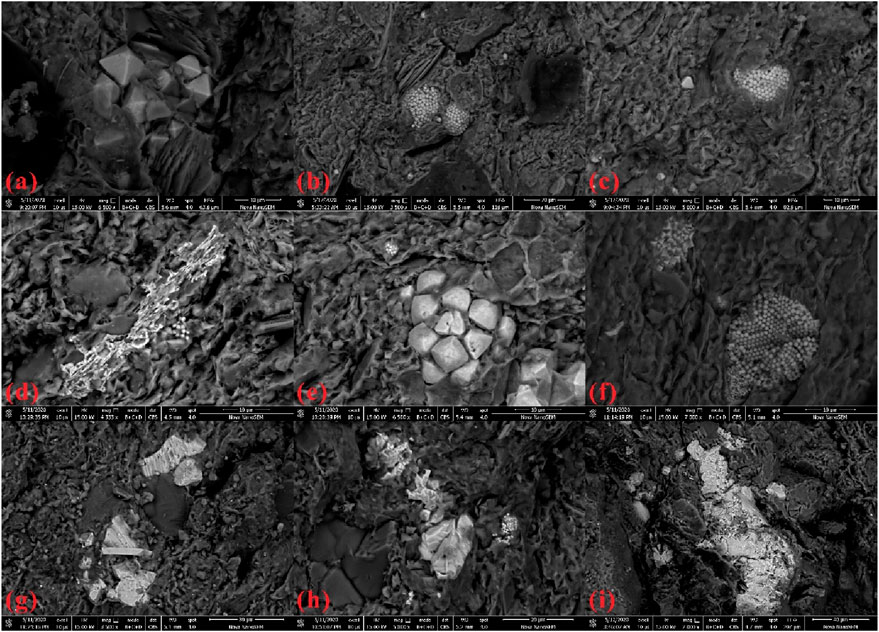
Figure 3. SEM photo of pyrite in mudstone of well QK-9 [(a). QK9-2; (b,c) QK9-4; (d,e) QK9-5; (f–h) QK9-17; (i) QK9-21].
5 Discussion
5.1 Evaluation of hydrocarbon source rocks
Organic matter abundance, a critical criterion for source rock evaluation, is quantified using TOC and hydrocarbon generation potential (S1 + S2) (Peters, 1986; Carvajal-Ortiz and Gentzis, 2015). The analyzed 27 mudstone samples exhibit TOC values of 0.07%–2.27% (average: 0.71%), while pyrolysis data from 13 samples show S1 + S2 values of 0.046–0.902 (average: 0.361). These results classify the middle member as fair to good source rock, contrasting with the poor quality of the upper and lower members (Figure 4).
Kerogen maceral analysis of six mudstone samples reveals Type II2 organic matter, supported by Type Index (TI) values of 15.8–28.0 (Table 2) and triangular maceral plots (Figure 5). The dominance of exinite (78%–84%) over vitrinite (12%–24%) and inertinite (3%–7%) reflects significant terrestrial input under oxic to suboxic depositional conditions.
Organic matter maturity is a critical parameter for evaluating the effectiveness of hydrocarbon source rocks. As maturity increases, organic matter sequentially transforms into oil, wet gas, and dry gas. Maturity classification is typically based on vitrinite reflectance (Ro) and pyrolysis Tmax values. Among these, Ro is the most widely used and direct indicator of thermal maturity (Tissot and Welte, 1984; Chen et al., 2012). The pyrolysis Tmax values of the Bagong Formation source rocks in this well, which span from 498°C to 557°C, in conjunction with Ro values ranging from 1.90% to 2.25% (with an average of 2.10%), suggest that these rocks are in the high to over-maturity stages, as indicated in Table 4. Cross-plots of Tmax versus Ro further confirm the over-mature characteristics of the samples (Figure 6). The consistency between pyrolysis parameters and vitrinite reflectance data robustly demonstrates that the source rocks predominantly reside in high to over-mature stages.
5.2 Depositional conditions of organic matter
Elemental geochemistry serves as a key method for paleoclimate reconstruction, as metal element concentrations in sediments systematically vary under different climatic conditions. Various proxies, including Mg/Ca, Al/Mg, Fe/Mn, and the Chemical Index of Alteration (CIA), are widely utilized for paleoclimate discrimination.
The Mg/Ca ratio is highly sensitive to climatic shifts. Elevated Mg/Ca values typically indicate arid conditions, whereas lower values reflect humid climates. However, under extreme aridity, Mg/Ca ratios decrease due to enhanced carbonate dissolution (Song, 2005). Similarly, the Al2O3/MgO ratio in clay minerals reflects paleoclimate dynamics. Higher values correlate with freshwater influx and warm-humid climates, whereas lower values denote arid settings (Liu and Zhou, 2007). The Fe/Mn ratio also provides climatic insights. Mn enrichment under arid conditions and Fe precipitation as colloidal Fe(OH)3 in humid environments result in high Fe/Mn ratios (>50) during warm-humid periods and low ratios (<30) in dry-hot climates (Song et al., 2019). The CIA, a robust indicator of chemical weathering intensity, delineates climatic regimes: CIA values of 50–60 indicate cold-dry climates with weak weathering, 60–80 represent warm-humid climates with moderate weathering, and 80–100 signify hot-humid climates with intense weathering (Fedo et al., 1995).
As clearly indicated in Figure 7, these four proxies collectively demonstrate a tripartite paleoclimate evolution within the Bagong Formation: warm-humid conditions in the lower member, a shift to dry-hot climates in the middle member, and a return to warm-humid conditions in the upper member. The geochemical proxies (Mg/Ca, Al/Mg, Fe/Mn ratios, and Chemical Index of Alteration) from core samples of Well QK-9 exhibit negative correlations with Total Organic Carbon (TOC) content, suggesting that relatively arid and warm paleoclimate conditions were more conducive to organic matter enrichment in sedimentary rocks (Figure 8).
Paleosalinity reflects the conditions of paleo-lake waters. It primarily affects the formation of high-quality hydrocarbon source rocks by influencing biological species and propagation intensity. The Sr abundance and Sr/Ba in metallic elements generally exhibit a positive correlation with paleosalinity. These parameters serve as effective indicators for discriminating salinity in lacustrine water bodies. Typically, Sr contents within the range of (800–1,000)×10–6 indicate a saline water environment, while those between (100–300)×10–6 suggest a freshwater setting. An Sr/Ba below 1 signifies a freshwater environment, whereas a ratio above one indicates a saline one (Cao et al., 2018).
Figure 7 shows distinct variations in these two salinity proxies throughout the stratigraphic sequence of the Bagong Formation. Specifically, both Sr/Bas and Sr abundance are relatively low at the top and bottom of the sequence, indicating lower salinity. In contrast, the middle section of the Bagong Formation exhibits significantly higher values for both proxies, suggesting increased salinity during the middle depositional phase. As illustrated in Figure 9, the geochemical indices (Sr/Ba ratio and Sr abundance) in the studied rock samples exhibit statistically significant positive correlations with total organic carbon (TOC) content, suggesting that elevated salinity conditions during deposition enhanced organic matter preservation.
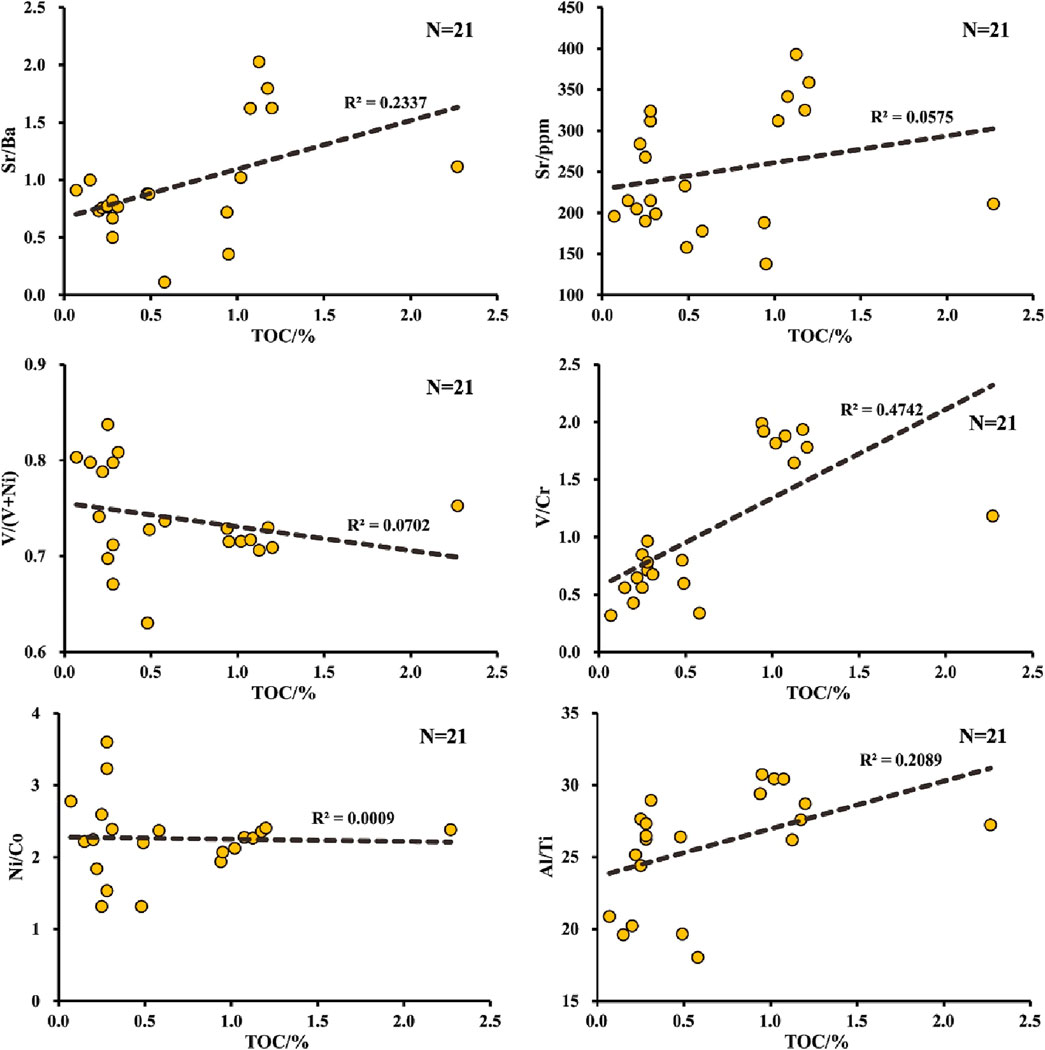
Figure 9. Crossplots of TOC versus Sr/Ba, Sr, V/(V + Ni), V/Cr, Ni/Co and Al/Ti of mudstones from Well QK-9.
Jones and Manning (1994) compared multiple parameters in their study of paleo-oxygenation facies in Late Jurassic dark argillaceous rocks of Northwestern Europe and identified U/Th, V/Cr, Ni/Co, and V/(V + Ni) ratios as the most reliable proxies. Based on their findings, a set of trace element ratio criteria was established for determining redox conditions in bottom water during sediment deposition (Table 5, which summarizes these criteria).
As shown in Figure 7, the redox proxies (V/Cr, Ni/Co) throughout the Bagong Formation, from base to top, generally indicate an oxygen-rich environment. However, the V/(V + Ni) ratio suggests a transition from anoxic to extremely dysoxic conditions, and finally to suboxic conditions. Compared to the middle section, the basal interval exhibits stronger anoxia and higher reducibility. Overall, the paleoredox environment of the Bagong Formation appears unfavorable for the preservation of organic matter. Figure 9 demonstrates variable correlations between salinity proxies and total organic carbon (TOC) in the analyzed samples. Weak correlations are observed for V/(V + Ni) and Ni/Co, while V/Cr exhibits a relatively strong positive correlation with TOC. These results suggest that paleoredox conditions played a minor role in controlling organic matter enrichment compared to depositional salinity variations.
Paleoproductivity is intimately linked to redox conditions and paleoclimate, directly mirroring organic matter enrichment patterns and forming the cornerstone for high TOC content-a vital indicator of high-quality hydrocarbon source rocks. Consequently, elemental ratios such as Ba content, Mo, and Ba/Al are frequently employed to estimate the paleoproductivity of hydrocarbon source rocks (Kryc et al., 2003; Ren et al., 2005; Algeo et al., 2007). Although these proxies cannot quantify the productivity of lacustrine source rocks heavily influenced by terrigenous material, they effectively reflect relative variations in paleoproductivity. Additionally, copper (Cu) primarily co-precipitates and buries with organic matter, serving as a robust indicator of organic matter flux. Enhanced Cu enrichment correlates with increased primary productivity, as demonstrated by Pinedo-González et al. (2015).
Figure 7 illustrates distinct differences in the variation trends of Ba, Ba/Al, and TOC. Notably, the higher Cu content in the middle section of the Bagong Formation, compared to its top and base, suggests elevated paleoproductivity during this depositional phase. Figure 10 demonstrates weak correlations between TOC and Ba, Mo, and Ba/Al ratios, while Cu exhibits a relatively strong positive correlation with TOC. This pattern suggests limited control of paleoproductivity on organic matter enrichment in the Bagong Formation of Well QK-9, though it partially reflects the influence of primary productivity dynamics.
5.3 Provenance analysis
Due to differences in elemental stability, certain trace and rare earth elements (REEs) with strong stability can effectively preserve geochemical information from source regions, making them widely used for characterizing provenance types. Sediments with stable material sources typically exhibit similar REE distribution patterns. The chondrite-normalized REE patterns (a method of normalizing REE concentrations to those of chondrite meteorites for comparison) of shale samples from the upper, middle, and lower members of the Bagong Formation (Figure 11) reveal consistent distribution characteristics across all three sub-members. Specifically, they exhibit gently right-leaning patterns with minimal curve fluctuations. Furthermore, the patterns display Eu negative anomalies (δEu < 1), which is consistent with the upper continental crust REE signature. This indicates a dominant upper crustal provenance for the Bagong Formation (Bhatia, 1985).
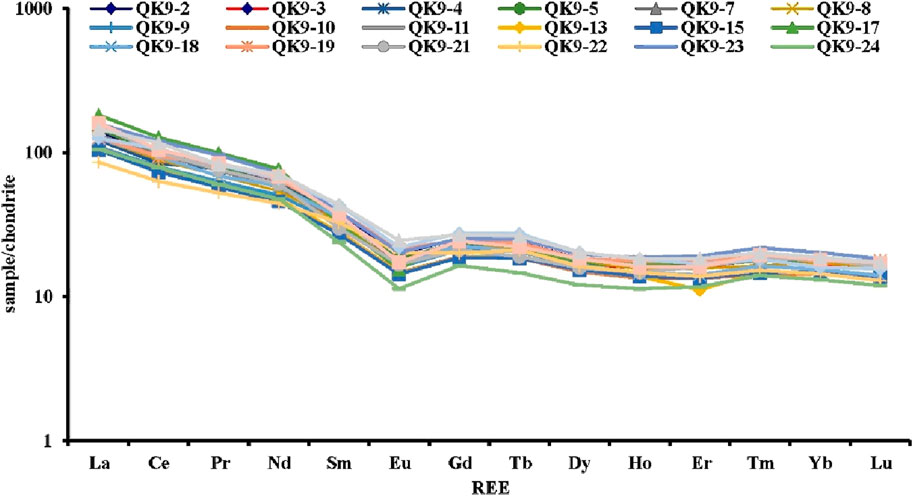
Figure 11. Standardized distribution pattern diagram depicting chondrites of rare earth elements from the Bagong Formation shale, North Qiangtang.
Roser and Korsch (1986) established discriminant functions, detailed in Table 6, for identifying sandstone and mudstone provenances based on major element compositions. The discriminant function plot demonstrates distinct source variations: Upper Member samples cluster primarily in the quartz arenite provenance field; Lower Member samples are mainly distributed in the acidic volcanic rock provenance field, with secondary affinity to quartz sandstone sources; and Middle Member samples plot within the intermediate volcanic rock provenance field (Figure 12a).

Table 6. Variables and their coefficients of discriminant function for provenance of sandstone and mudstone.
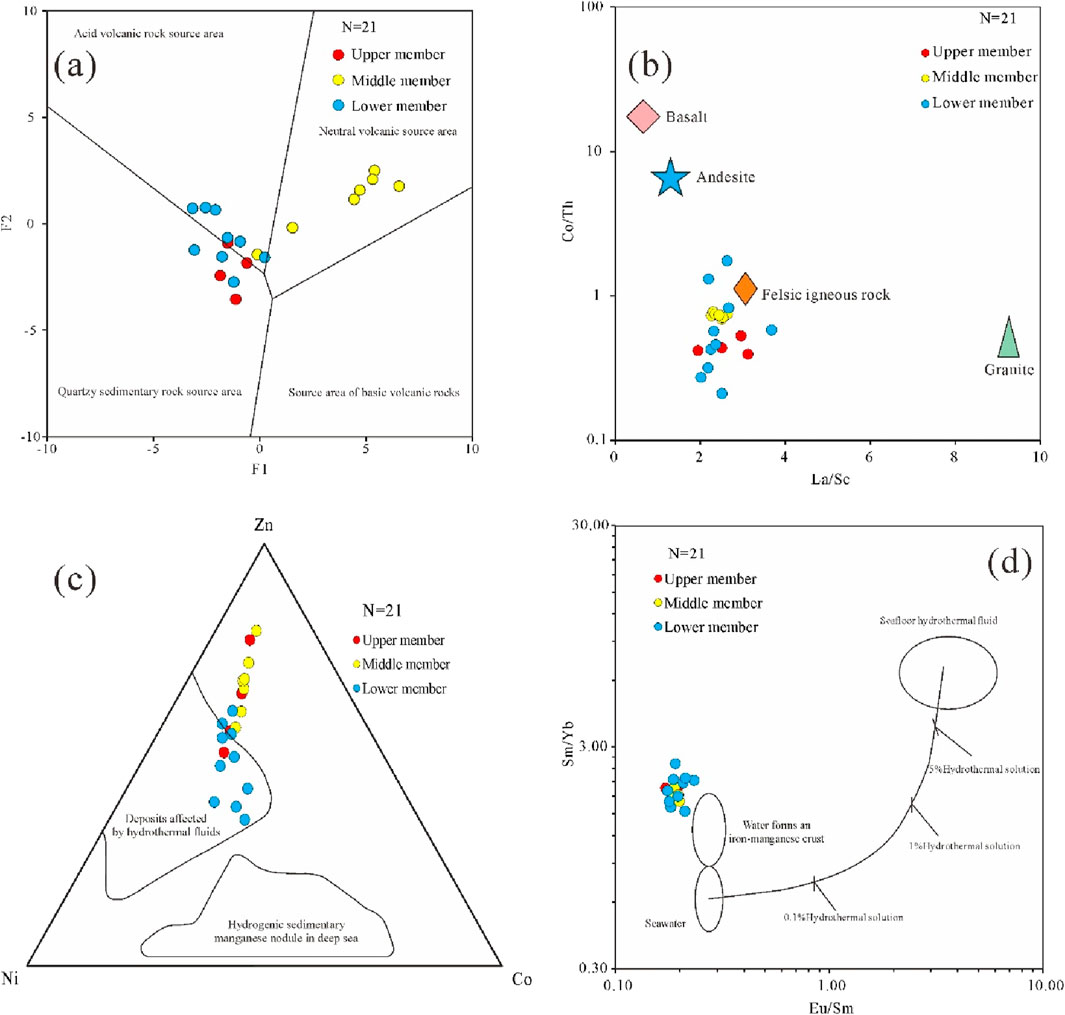
Figure 12. Discrimination diagram of the Bagong Formation shale, North Qiangtang (a) Discriminant Coefficient Diagram of F1 and F2 (b) Diagram of Co/Th versus La/Sc (c) Provenance Discrimination Diagram of Zn, Ni, and Co (d) Diagram of Eu/Sm versus Sm/Yb.
During continuous magmatic evolution, elements such as La and Th become progressively enriched, while Sc and Co are gradually depleted. Consequently, acidic igneous rocks typically exhibit higher La/Sc ratios and lower Co/Th values (Gu et al., 2002). Samples from the study area predominantly cluster near the felsic igneous rock field in the La/Sc vs. Co/Th diagram (Figure 12b), suggesting their protoliths were likely derived from felsic igneous rocks.
The Zn-Ni-Co ternary diagram is another method for assessing hydrothermal influence (Li et al., 2024). This diagram shows that samples from the lower member of the Bagong Formation mainly plot within or near the hydrothermally influenced sedimentary zone (Figure 12c), indicating significant hydrothermal activity affecting the lower member mudstones. Alexander et al. (2008) proposed the Eu/Sm vs Sm/Yb binary diagram to evaluate contributions from seawater versus submarine hydrothermal fluids. Shale samples from all sub-members of the Bagong Formation in the study area plot close to the hydrogenetic ferromanganese crust field (Figure 12d), implying a minimal hydrothermal contribution (<0.1%) to the original solutions. The Al/Ti ratio serves as a widely utilized proxy for terrestrial input in sedimentological studies. Aluminum primarily hosted in clay minerals (e.g., illite, montmorillonite), and titanium typically associated with heavy minerals (e.g., rutile, ilmenite), both exhibit conservative geochemical behavior in surficial environments. Consequently, elevated Al/Ti ratios generally indicate enhanced clay-rich fine-grained input, whereas reduced ratios may reflect increased contributions from coarse-grained detritus (Tribovillard et al., 2006). As shown in Figure 7, the Middle Member of the Bagong Formation demonstrates significantly higher Al/Ti ratios compared to its Upper and Lower Members. Figure 9 further reveals a positive correlation between Al/Ti ratios and total organic carbon (TOC) content, suggesting that enhanced terrestrial input played a constructive role in promoting organic matter enrichment.
5.4 Pyrite and sulfur isotope characteristics
Compared to diagenetic pyrite (BSR, Bacterial Sulfate Reduction), TSR-derived pyrite exhibits lower abundance and poorly defined crystal forms, often presenting as veins, lenses, or irregular aggregates. In contrast, BSR-derived pyrite forms near the sediment-water interface or in shallow burial environments under lower temperatures (Machel, 1987).
Wilkin et al. (1996) propose that framboidal pyrite preserves its primary structure through early diagenesis and limited secondary growth, with spherule size encoding environmental signals. Framboids may form either in sediment pore waters or sulfide-rich water columns above sediments, distinguished by size differences: Syngenetic framboids precipitated from sulfide-rich water columns rapidly settle to the sediment-water interface under gravity, resulting in smaller diameters (<6 μm) and narrow size distributions due to restricted crystal growth. Pore-water framboids develop over prolonged periods, exhibiting larger diameters (>10 μm) and broader size ranges.
Scanning electron microscopy (SEM) observations reveal that Bagong Formation source rocks are exceptionally enriched in framboidal pyrite, with occasional aggregated, filamentous, octahedral, or dodecahedral forms. Framboid diameters vary widely (5–30 μm), indicating diagenetic pyrite formation in sediment pore waters.
Hydrothermal pyrite inherits the sulfur isotopic composition of sulfate from its hydrothermal source, typically derived from anhydrite in sediments or the re-oxidation of pyrite formed in later confined environments. TSR (thermochemical sulfate reduction)-derived pyrite commonly exhibits elevated sulfur isotopic values (Gomes et al., 2018). In contrast, bacterial sulfate reduction (BSR), involving sulfate-reducing bacteria, can produce significant sulfur isotope fractionation due to the complexity of the reaction process, leading to a wide range of sulfur isotope values in pyrite (Riciputi et al., 1996).
In the Bagong Formation, pyrite development is abundant in hydrocarbon source rock samples from the upper and lower segments, but lacking in the middle segment. The pyrite content in these segments varies widely, ranging from 0.6% to 19.8% with an average of 3.2%, and most values are below 5%. The sulfur isotopic composition of pyrite (δ 34S) spans from −29.1‰ to +18.6‰, with most values above 0‰, indicating a sedimentary origin (BSR-derived pyrite). Sedimentary pyrite typically forms under anoxic conditions, where organic matter acts as a reductant, reducing sulfate to H2S by sulfate-reducing bacteria. This H2S then reacts with reactive iron to form mackinawite (FeS), which subsequently transforms into various pyrite morphologies (Berner, 1984).
The differential pyrite distribution in the Bagong Formation is controlled by paleoclimate factors. Specifically, the upper and lower segments experienced warm and humid climates, elevated sea levels, and relatively reducing seafloor conditions, which favored pyrite formation. In contrast, the middle segment was characterized by a dry and cold climate, lowered sea levels, and oxygen-enriched seafloor environments, which inhibited pyrite generation.
Regarding the significant variations in sulfur isotopic compositions observed in pyrite from the upper and lower segments of the Bagong Formation, studies suggest that frequent multi-phase volcanic activities during the deposition of these strata may have caused pyrite to inherit sulfur isotopic signatures from hydrothermal sulfate sources (Zeng, 2021). This process likely contributed to the pronounced positive δ 34S shifts and substantial isotopic variability in these intervals.
5.5 Mechanism of organic matter enrichment
The mechanism of organic matter enrichment represents one of the most complex physical and chemical processes in nature. The abundance of organic matter in sediments reflects the interplay of various marine and depositional conditions, including paleoproductivity, redox conditions of water bodies, sedimentation rates, and organic carbon degradation rates. Each depositional environment may exhibit specific factors contributing to organic matter enrichment in sediments. In general, geological factors such as paleoclimate, paleoproductivity, and preservation conditions of water bodies all play significant roles in the organic matter enrichment process (Tissot and Welte, 1984). Through analysis and research on paleoproductivity, redox conditions, and sedimentation rates, the dominant controlling factors of organic matter enrichment in the hydrocarbon source rocks of the Bagong Formation have been identified.
Based on the evaluation results of the Bagong Formation source rocks and analytical data of elemental composition and pyrite content, the following understandings are derived. As indicated in Figure 9, the paleoredox characteristics reflected by V/(V + Ni) and V/Cr parameters show inconsistency, while the extremely weak correlation between Ni/Co and TOC suggests that paleoredox conditions exerted limited control on organic matter enrichment. Similarly, Figure 11 demonstrates minimal correlation between Ba/Al and TOC, weak negative correlations between Mo-TOC and Ba-TOC, and a relatively strong positive correlation between Cu and TOC. These differential correlations among paleoproductivity parameters and TOC indicate that paleoproductivity also played a minor role in controlling organic enrichment.
Figure 7 reveals consistent negative correlations between TOC and Mg/Ca, Al/Mg, Fe/Mn, and CIA parameters (despite varying R2 values), collectively suggesting that arid-hot climatic conditions favored organic matter enrichment and preservation in source rocks. Figure 9 demonstrates positive correlations between salinity indicators (Sr/Ba and Sr content) and TOC, indicating enhanced organic enrichment under high salinity conditions. Figure 9 shows a strong positive correlation between the terrigenous input proxy (Al/Ti) and TOC, revealing the importance of high terrestrial input for organic accumulation.
Integrating these multi-factor correlations, we propose the following paleoenvironmental evolution model for organic enrichment: During lower member deposition, relatively warm-humid climate with rising water levels increased the transport distance and difficulty for terrigenous organic input, resulting in lower organic abundance. Concurrently, reduced salinity weakened water stratification and enhanced bottom water oxygenation, deteriorating organic preservation. The widespread BSR-type pyrite distribution further indicates substantial organic consumption during diagenesis. These factors collectively contributed to poor source rock quality in the lower member.
During middle member deposition, the shift to arid-hot climate with falling water levels facilitated terrigenous organic input, while enhanced salinity strengthened water stratification and reduced oxygen exchange, creating favorable preservation conditions. The absence of BSR-type pyrite suggests minimal organic consumption. These conditions led to the development of high-quality type II2 source rocks. Studies have shown that the concentration of heavy carbon isotope in the organic matter (OM) in the surface layer of the marine sediment increases and the amount of terrigenous OM decreases by about 1.4 times with increasing distance from the Indigirka River delta from 50 km to 600 km. (Sevastyanov et al., 2020).
Upper member deposition resumed warm-humid conditions similar to the lower member, resulting in comparable poor source rock characteristics (Figure 13).
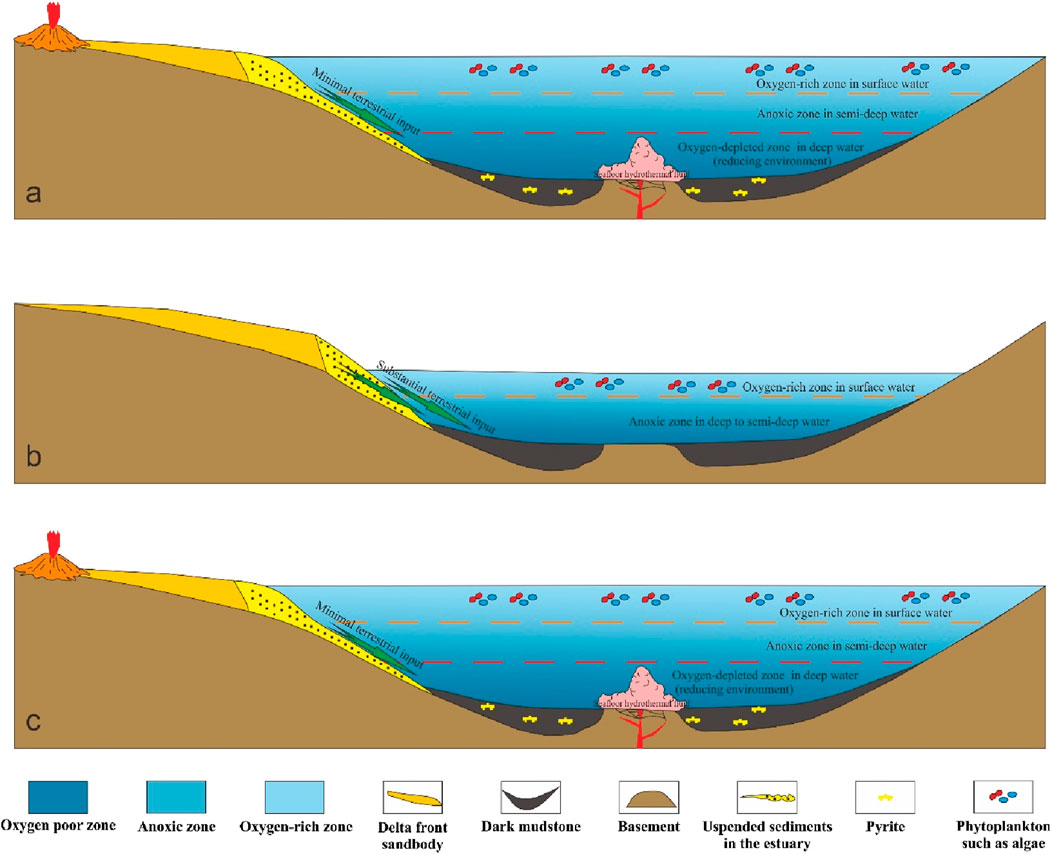
Figure 13. Evolutionary model of depositional environments controlled by climate-volcanic interactions in the Bagong Formation: (a) Upper Member; (b) Middle Member; (c) Lower Member.
The clay mineralogical study of the Newark Basin in the United States reveals a sharp decline in the illite/smectite ratio during the mid-Norian stage (∼215 Ma), reflecting an increase in chemical weathering intensity associated with enhanced seasonal precipitation in high-latitude regions (Kent et al., 2017). This phenomenon may bear analogy to the terrestrial organic matter input characteristics observed in the Bagong Formation. In the coal-bearing shallow-water deltaic deposits of the Mungaroo Formation in the Northern Carnarvon Basin, Australia, organic matter dominated by C3 plants (δ13Corg = −24‰ to −26‰) alternates with red beds, indicating 104-year-scale fluctuations in monsoon intensity in northwestern Australia during the Norian (Zeng et al., 2023). Such climatic instability may influence the enrichment patterns of hydrocarbon source rocks.
The study by Sun et al. (2024) focuses on high-resolution geochemical characteristics of the Lucaogou Formation in the Junggar Basin, exploring the relationship between climatic fluctuations and the enrichment of organic matter. The research demonstrates that climate change directly influenced sedimentary environments, thereby controlling the accumulation of organic matter. Similar to the Bagong Formation, the Lucaogou Formation exhibits a wet-dry-wet climatic sequence, with Total Organic Carbon (TOC) content showing lower values in the upper and lower sections but higher values in the middle interval.
Wang et al. (2022) proposed that the hydrocarbon source rocks of the Bagong Formation in the Dongqu section of the Qiangtang Basin are predominantly composed of Type II2 kerogen, influenced by significant terrestrial organic matter input, and were deposited in a relatively suboxic environment. In different structural units of the Qiangtang Basin, there are inevitable differences in the development processes of source rocks, and the dominant controlling factors for organic matter enrichment may vary among different hydrocarbon source rocks. Under the comprehensive consideration of controlling conditions such as sedimentary conditions, tectonic activities, and volcanic events, a region-specific analysis should be conducted to investigate the enrichment patterns of organic matter in source rocks within specific areas.
Regarding BSR-type pyrite formation, our observations reveal an apparent paradox: The middle member exhibits high salinity and relative hypoxia but lacks pyrite, whereas upper/lower members with lower salinity and more oxic conditions show frequent BSR occurrences. This suggests differential weighting between salinity and redox conditions in controlling sulfate-reducing bacterial activity - where high salinity may dominantly inhibit BSR processes despite favorable redox conditions. Although conclusive evidence remains elusive, this mechanism warrants further investigation to clarify the relative importance of these controlling factors.
6 Conclusion
6.1 Vertical differentiation of source rock quality in the Bagong Formation
The Bagong Formation source rocks display marked vertical heterogeneity, characterized by high-quality intervals in the middle member and inferior organic-rich layers in the upper/lower members. This stratification is governed by coupled paleoclimate-paleosalinity dynamics. Humid, low-salinity conditions during upper/lower member deposition restricted terrigenous nutrient delivery while promoting sulfate-reducing bacterial (SRB) activity, collectively compromising organic preservation. Conversely, an arid-hot climatic phase during middle member deposition induced marine regression, elevating salinity. This salinity rise concurrently stimulated terrigenous nutrient flux and restricted microbial activity, markedly enhancing organic preservation efficiency.
6.2 BSR-mediated pyritization and its impact on hydrocarbon potential
Pervasive bacteriogenic pyrite concentrations in upper/lower members record extensive sulfate-reducing bacterial (SRB) activity that preferentially metabolized bioavailable organic fractions. While subsequent H2S accumulation partially inhibited heterotrophic degradation of recalcitrant organic matter, the prior depletion of labile hydrocarbon precursors resulted in irreversible reduction of generative potential-a key determinant of source rock inferiority in these intervals.
6.3 Terrigenous-oxygenation synergy model and exploration implications
We propose a “terrigenous influx-high salinity inhibition” co-preservation model to explain the formation of high-quality source rocks in the middle member: Marine regression enhanced terrigenous nutrient delivery, while high-salinity bottom waters effectively suppressed microbial degradation. These dual controls synergistically promoted efficient organic sequestration. This model elucidates the critical coupling between paleoclimate oscillations and depositional environments in source rock development, establishing a diagnostic framework for identifying hydrocarbon-rich intervals in plateau exploration domains.
Data availability statement
The original contributions presented in the study are included in the article/Supplementary material, further inquiries can be directed to the corresponding author.
Author contributions
RW: Writing – original draft, Writing – review and editing. SZ: Writing – original draft. GZ: Writing – original draft, Writing – review and editing. XW: Writing – review and editing. JS: Writing – original draft. SP: Writing – original draft. JY: Writing – original draft.
Funding
The author(s) declare that no financial support was received for the research and/or publication of this article.
Conflict of interest
The authors declare that the research was conducted in the absence of any commercial or financial relationships that could be construed as a potential conflict of interest.
Generative AI statement
The author(s) declare that no Generative AI was used in the creation of this manuscript.
Publisher’s note
All claims expressed in this article are solely those of the authors and do not necessarily represent those of their affiliated organizations, or those of the publisher, the editors and the reviewers. Any product that may be evaluated in this article, or claim that may be made by its manufacturer, is not guaranteed or endorsed by the publisher.
References
Alexander, B. W., Bau, M., Andersson, P., and Dulski, P. (2008). Continentallyderived solutes in shallow Archean seawater: rare earth element and Nd isotope evidence in iron formation from the 2.9 Ga Pongola Supergroup, South Africa. Geochimica Cosmochimica Acta 72 (2), 378–394. doi:10.1016/j.gca.2007.10.028
Algeo, T. J., Lyons, T. W., Blakey, R. C., and Over, D. J. (2007). Hydrographic conditions of the devono–carboniferous North American seaway inferred from sedimentary Mo-TOC relationships. Palaeogeogr. Palaeoclimatol. Palaeoecol. 256 (3-4), 204–230. doi:10.1016/j.palaeo.2007.02.035
Ashraf, U., Zhang, H., Anees, A., Zhang, X., and Duan, L. (2024). Assessment of lake-level variations to decipher geological controlling factors and depositional architecture of Lake Fuxian, Yunnan Plateau: preliminary insights from geophysical data. Geomech. Geophys. Geo-energ. Geo-resour. 10, 64. doi:10.1007/s40948-024-00777-7
Berner, R. A. (1984). Sedimentary pyrite formation: An update. Geochimica cosmochimica Acta 48 (4), 605–615. doi:10.1016/0016-7037(84)90089-9
Bhatia, M. R. (1985). Rare earth element geochemistry of Australian Paleozoic graywackes and mudrocks: provenance and tectonic control. Sediment. Geol. 45, 97–113. doi:10.1016/0037-0738(85)90025-9
Cao, J., Yang, R., Yin, W., Hu, G., Bian, L., and Fu, X. (2018). Mechanism of organic matter accumulation in residual bay environments the early cretaceous Qiangtang Basin, tibet. Energy fuels. 32, 1024–1037. doi:10.1021/acs.energyfuels.7b02248
Carvajal-Ortiz, H., and Gentzis, T. (2015). Critical considerations when assessing hydrocarbon plays using Rock-Eval pyrolysis and organic petrology data: data quality revisited. Int. J. Coal Geol. 152, 113–122. doi:10.1016/j.coal.2015.06.001
Chen, C., Wu, Z., Zhao, W., Li, W., Ji, C., Zhen, Z., et al. (2024). Formation environment and organic matter enrichment mechanism of high-quality source rocks in the Buqu Formation in the Shenglihe area, northern Qiangtang basin. Acta Geol. Sin. 98 (2), 530–543.
Chen, J., Digang, L., Zhang, S., Chunping, D., Zhe, Z., and Zhang, D. (2012). Evaluation criterion and methods of the hydrocarbon generation potential for China’s paleozoic marine source rocks. Acta Geol. Sin. 86 (7), 1132–1142. doi:10.3969/j.issn.0001-5717.2012.07.009
Chen, W., Fu, X., Tan, F., Xinglei, F., and Zeng, S. (2015). Geochemical characteristics of Upper Triassic source rocks from typical sections in Qiangtang Basin, northern Tibet. Geol. China 42 (4), 1152–1160.
Falak, S., Wei, L., Zhang, L., Basil, A., Jiang, L., Liang, L., et al. (2024). Structural Geology and chronology of shear zones along the shangdan suture in qinling orogenic Belt, China: implications for late mesozoic intra-continental deformation of east asia. J. Earth Sci. 35 (2), 376–393. doi:10.1007/s12583-022-1753-7
Fedo, C. M., Wayne Nesbitt, H., and Grant, M. (1995). YoungUnraveling the effects of potassium metasomatism in sedimentary rocks and paleosols, with implications for paleoweathering conditions and provenance. Geology 23 (10), 921–924. doi:10.1130/0091-7613(1995)0232.3.CO;2
Fu, X., Wang, J., Song, C., and Liu, Z. (2020). Petroleumgeological achievements and exploration significance of the first oil and gas scientific drilling well in the Qiangtang Basin. Sediment. Geol. Tethyan Geol. 40 (1), 15–25. doi:10.19826/j.cnki.1009-3850(2020)01-0015-10
Gomes, M. L., Fike, D. A., Bergmann, K. D., Jones, C., and Knoll, A. H. (2018). Environmental insights from high-resolution (SIMS)sulfur isotope analyses of sulfides in Proterozoic microbialites with diverse mat textures. Geobiology 16 (1), 17–34. doi:10.1111/gbi.12265
Gu, X. X., Liu, J. M., Zheng, M. H., Tang, J., and Qi, L. (2002). Provenance and tectonic setting of the proterozoic turbidites in hunan, south China: geochemical evidence. J. Sediment. Res. 72 (3), 393–407. doi:10.1306/081601720393
Han, R., Yan, Z., Wenlong, Q., Tianzhu, D., Mingzhi, W., and Feng, W. (2023). Geology and geochemistry of Zn-Pb(-Ge-Ag) deposits in the Sichuan-Yunnan-Guizhou Triangle area, China: a review and a new type. Front. Earth Sci. 11, 1136397. doi:10.3389/feart.2023.1136397
Jones, B., and Manning, D. A. C. (1994). Comparison of geochemical indices used for the interpretation of palaeoredox conditions in ancient mudstones. Chem. Geol. 111, 111–129. doi:10.1016/0009-2541(94)90085-x
Kent, D. V., Olsen, P. E., and Muttoni, G. (2017). Astrochronostratigraphic polarity time scale (APTS) for the Late Triassic and Early Jurassic from continental sediments and correlation with standard marine stages. Earth-Science Rev. 166, 153–180. doi:10.1016/j.earscirev.2016.12.014
Kryc, K. A., Murray, R. W., and Murray, D. W. (2003). Al-to-oxide and Ti-to-organic linkages in biogenic sediment: relationships to paleo-export production and bulk Al/Ti. Earth Planet. Sci. Lett. 211, 125–141. doi:10.1016/s0012-821x(03)00136-5
Li, J., Chen, L., Hu, Y., Ji, Y., Lu, C., Dong, J., et al. (2024). Element geochemical characteristics and their geological significance of late Ordovician-early Silurian black shale in Zhaotong area of northern Yunnan and Guizhou. Acta Sedimentol. Sin. 42(3), 738–756. doi:10.14027/j.issn.1000⁃0550.2024.038
Liu, C., Yang, X., Ren, Z., Lai, S., Gang, C. C., Hongge, Z., et al. (2001). Tectonic pattern and evolution in Chasang area of Qiangtang basin, northern Tibet. Sci. China (Series D) 48 (s1), 14–19. doi:10.3321/j.issn:0371-5736.2002.06.016
Liu, C., Yang, X., Ren, Z.Li, Zheng, M., and Lai, S. (2005). Genesis of subsidence-accumulation centre in Quemocuo area of Qiangtang basin: caving-in subsidence with thermal attenuation. Oil and Gas Geol. 26 (2), 147–154. doi:10.3321/j.issn:0253-9985.2005.02.005
Liu, C., Zheng, M., Yang, X., He, B., Zhili, R., and Pei, G. (2016). Evolution and late modification of Mesozoic marine Qiangtang Basin and its hydrocarbon occurrence. Acta Geol. Sin. 90 (11), 3259–3291. doi:10.3969/j.issn.0001-5717.2016.11.018
Liu, G., and Zhou, D. (2007). Application of micro elements analysis in identifying sedimentary environment. Petroleum Geol. Exp. 29 (3), 307–314. doi:10.11781/sysydz200703307
Liu, Z. R., Yang, P., Zhang, G., Fan, Z. W., Han, J., and Tan, F. W. (2022). Sedimentary model and its implications for oil and gas exploration of upper triassic in northern Qiangtang depression. Sediment. Geol. Tethyan Geol. 42 (3), 465–480. doi:10.19826/j.cnki.1009-3850.2022.08001
Lu, Z., Gao, R., Yongtie, L., Aimin, X., Qiusheng, L., WangHaiyan, K. C., et al. (2013). The upper crustal structure of the Qiangtang basin revealed by seismic reflection data. Tectonophysics 606, 171–177. doi:10.1016/j.tecto.2013.07.019
Machel, H. G. (1987). Some aspects of diagenetic sulphate-hydrocarbon redox reactions. Geol. Soc. Lond. Spec. Publ. 36 (1), 15–28. doi:10.1144/gsl.sp.1987.036.01.03
Nan, Z., Li, Y., and Guo, Z. (2008). Hydrocarbon show and correlation between oil and source rock in the Qiangtang Basin. Petroleum Geol. and Exp. 30 (5), 503–507. doi:10.3969/j.issn.1001-6112.2008.05.015
Peters, K. E. (1986). Guidelines for evaluating petroleum source rock using programmed pyrolysis. AAPG Bull. 70 (3), 318–329. doi:10.1306/94885688-1704-11d7-8645000102c1865d
Pinedo-González, P., West, A. J., Tovar-Sánchez, A., Duarte, C. M., Marañón, E., Cermeño, P., et al. (2015). Surface distribution of dissolved trace metals in the oligotrophic ocean and their influence on phytoplankton biomass and productivity. Glob. Biogeochem. Cycles 29, 1763–1781. doi:10.1002/2015GB005149
Qinghe, N., Jie, W., He, J., Yuan, W., Chang, J., Wang, W., et al. (2025). Evolution of pore structure, fracture morphology and permeability during CO2+O2 in-situ leaching process of fractured sandstone. Energy 315, 134348. doi:10.1016/j.energy.2024.134348
Qinghe, N., Mingwei, H., Chang, J., Wang, W., Yuan, W., Wang, Q., et al. (2024). Explosive fracturing mechanism in low-permeability sandstone-type uranium deposits considering different acidification reactions. Energy 312, 133676. doi:10.1016/j.energy.2024.133676
Ren, J., Zhang, J., and Liu, S. (2005). A review on aluminum to titanium ratio as a geochemical proxy to reconstruct paleoproductivity. Adv. Earth Sci. 20 (12), 1314–1320.
Riciputi, L. R., Cole, D. R., and Machel, H. G. (1996). Sulfide formation in reservoir carbonates of the Devonian Nisku Formation, Alberta, Canada:An ion microprobe study. Geochimica Cosmochimica Acta 60 (2), 325–336. doi:10.1016/0016-7037(96)83133-4
Roser, B. P., and Korsch, R. J. (1988). Provenance signatures of sandstonemudstone suites determined using discriminant function analysis of major-element data. Chem. Geol. 67 (1/2), 119–139. doi:10.1016/0009-2541(88)90010-1
Sevastyanov, V. S., Kuznetsova, O. V., Fedulov, V. S., Fedulova, V.Yu., Dushenko, N. V., Naimushin, S. G., et al. (2020). Accumulation of organic matter, heavy metals, and rare-earth elements in marine sediment at different distance from the Indigirka River delta. Geochem. Int. 58 (12), 1313–1320. doi:10.1134/s0016702920120046
Shen, A., Fu, X., Zhang, J., Wei, X., Hu, A., and Wang, J. (2023). Characteristics and discovery significance of the upper triassic-lower jurassic marine shale oil in Qiangtang Basin, NW China. Petroleum Explor. Dev. 50 (5), 962–974. doi:10.11698/PED.20230001
Song, C., Wang, J., Fu, X., Chen, W., Xie, S., and He, L. (2018). Geochemical characteristics and the significance of the Upper Triassic hydrocarbon source rocks of the Bagong formation in the eastern Qiangtang basin. J. Of Northeast Petroleum Univ. 42 (5), 104–114. doi:10.3969/j.issn.2095-4107.2018.05.011
Song, M. (2005). Sedimentary environment geochemistry in the Shasi section of southern ramp, Dongying depression. Journal of Mineralogy and Petrology. 25(1), 67–73.
Song, Y., Li, S., and Hu, S. (2019). Warm-humid paleoclimate control of salinized lacustrine organic-rich shale deposition in the Oligocene Hetaoyuan Formation of the Biyang Depression, East China. Int. J. Coal Geol. 202, 69–84. doi:10.1016/j.coal.2018.11.016
Sun, S., Zhang, B., Wang, X., Xiao, W., Tian, H., Hou, G., et al. (2024). High-resolution geochemistry in the Lucaogou Formation, Junggar Basin: climate fluctuation and organic matter enrichment. Mar. Petroleum Geol. 162, 106734. doi:10.1016/j.marpetgeo.2024.106734
Tan, F., Yang, C., Chen, F., Du, F., Liu, Z., Jiang, X., et al. (2020). Sedimentary facies and its control over petroleum and other resources of upper triassic Bagong Formation in baqing area, southeastern Qiangtang Basin. Geol. China 47 (1), 57–71. doi:10.12029/gc20200105
Tissot, B. P., and Welte, D. H. (1984). Petroleum formation and occurrence. New York: Springer-Verlag, 966.
Tribovillard, N., Algeo, T. J., Lyons, T., and Riboulleau, A. (2006). Trace metals as paleoredox and paleoproductivity proxies: an update. Chem. Geol. 232(1-2), 12–32. doi:10.1016/j.chemgeo.2006.02.012
Ullah, S., Jan, I. U., Hanif, M., Latif, K., Mohibullah, M., Sabba, M., et al. (2022). Paleoenvironmental and bio-sequence stratigraphic analysis of the cretaceous pelagic carbonates of eastern tethys, sulaiman range, Pakistan. Minerals 12, 946. doi:10.3390/min12080946
Ullah, Z., Li, H., Khan, A., Shah, F., Dilek, Y., Förster, M. W., et al. (2023). Mineralogy and PGE geochemistry of chromitites and peridotites of the sapat complex in the indus suture zone, northern Pakistan: implications for magmatic processes in the supra-subduction zone. Int. Geol. Rev. 65 (10), 1719–1744. doi:10.1080/00206814.2022.2106519
Umar, A., Zhang, H., Anees, A., Ali, M., Hassan, N. M., and Zhang, X. (2024). An ensemble-based strategy for robust predictive volcanic rock typing efficiency on a global-scale: a novel workflow driven by big data analytics. Sci. Total Environ. 937, 173425. doi:10.1016/j.scitotenv.2024.173425
Wang, C., Yi, H., Liu, C., Li, Y., Zou, Y., Wu, X., et al. (2004). Discovery of paleo-oil-reservoir in Qiangtang basin in Tibet and its geological significance. Oil and Gas Geol. 25 (2), 139–143. doi:10.3321/j.issn:0253-9985.2004.02.004
Wang, C., Yi, H., Yong, L., and Bin, D. (2001). Geological evolution and prospective evaluation for oil and gas of the Qiangtang Basin, Tibet. Beijing: Geological Publishing House.
Wang, J., and Fu, X. (2018). Sedimentary evolution of the Qiangtang Basin. Geol. China 45 (2), 237–259. doi:10.12029/gc20180203
Wang, J., Tan, F., Li, Y., Li, Y., Chen, M., Wang, C., et al. (2004). The potential of the oil and gas resources in major sedimentary basins on the Qinghai-Xizang plateau. Beijing: Geological Publishing House.
Wang, J., Jun, D., Wang, C., and Tan, F. (2009). Investigation and evaluation of strategic constituency of oil and gas resources in Qinghai-Tibet Plateau. Beijing: Geological Publishing House.
Wang, L., Su, A., Zheng, Y., Chao, L., and Kai, J. (2012). Characteristics of Mesozoic marine black shales and prediction of shale gas prospective area in Qiangtang Basin, Tibet. Earth Sci. Front. 19 (3), 264–279.
Wang, L., Yan, Z., Han, R., and Xiaodong, L. (2023). LA-ICP-MS analyses of trace elements in zoned sphalerite: a study from the Maoping carbonate-hosted Pb-Zn(-Ge) deposit, southwest China. Ore Geol. Rev. 157, 105468. doi:10.1016/j.oregeorev.2023.105468
Wang, Z., Wang, J., Fu, X., Zhan, W., Armstrong-Altrin, J. S., Yu, F., et al. (2018). Geochemistry of the upper triassic black mudstones in the Qiangtang Basin, tibet: implications for paleoenvironment, provenance, and tectonic setting. J. Asian Earth Sci. 160, 118–135. doi:10.1016/j.jseaes.2018.04.022
Wang, Z., Yang, X., Wangzhong, Z., and Fei, Y. (2022). Geochemical characteristics of the upper triassic Bagong Formation mudstones in eastern Qiangtang Basin and its petroleum geological significance. J. Of Northeast Petroleum Univ. 46 (2), 1–12. doi:10.3969/j.issn.2095-4107.2022.02.001
Wilkin, R. T., Barnes, H. L., and Brantley, S. L. (1996). The size distribution of framboidal pyrite in modern sediments: an indicator of redox conditions. Geochimica Cosmochimica Acta 60 (20), 3897–3912. doi:10.1016/0016-7037(96)00209-8
Wu, Z. H., Ji, C., Zhao, Z., and Chen, C. (2020). Buried depth evolution and hydrocarbon generation history of the Jurassic System in central Qiangtang Basin. Acta Geol. Sin. 94 (10), 2823–2833. doi:10.3969/j.issn.0001-5717.2020.10.003
Wu, Z. H., Zhao, Z., Ji, C., and Chen, C. (2021). Geological time of marine source rocks in the Woruoshan Mountain and its adjacent areas, northern Qiangtang depression. Acta Geol. Sin. 95 (2), 352–361. doi:10.3969/j.issn.0001-5717.2021.02.005
Wu, Z. H., Yao, J., Ji, C., Zhao, Z., Yang, X., Feng, W., et al. (2022). Crude oil and formation history of hydrocarbon in the Shenglihe area, northern Qiangtang basin. Acta Geol. Sin. 96 (11), 3698–3704. doi:10.3969/j.issn.0001-5717.2022.11.002
Wu, Z. H., Ji, C., Zhao, Z., Kang, S., Zhao, R., and Lei, Y. (2023). Oil-soaked dolomite in upper reach of the shenglihe River, Northern Qiangtang. Acta Geosci. Sin. 44 (3), 411–418. doi:10.3975/cagsb.2022.061801
Yin, Y., Chen, J., Zhao, Z., Yang, Y., Chenglu, L., Haina, L., et al. (2025). Integrated geophysical prospecting for deep ore detection in the Yongxin gold mining area, Heilongjiang, China. Sci. Rep. 15, 7258. doi:10.1038/s41598-025-92108-3
Yong, L., Chengshan, W., and Haisheng, Y. (2003). The late triassic collision and sedimentary responses at western segment of jinshajiang suture, tibet. Acta Sedimentol. Sin. 21 (2), 191–197. doi:10.3969/j.issn.1000-0550.2003.02.001
Zeng, S. (2021). Study on the sedimentary sequences and basin transformation of the end-Triassic to Early-Middle Jurassic period in the northern Qiangtang Basin[D]. Chengdu: Chengdu University of Technology.
Zeng, S., Wang, J., Fu, X., Feng, X., and Sun, W. (2013). Hydrocarbon generation potential and sedimentary environment for the source rocks along the Changshe Mountain oil shale section in North Qiangtang Basin. Geol. China 40 (6), 1861–1871. doi:10.3969/j.issn.1000-3657.2013.06.015
Zeng, Z., Wang, W., Zhu, H., Yang, X., and Li, D. (2023). The facies analysis, evolution, and coal-bearing source rock features of the middle–late triassic shallow-water delta in the North Carnarvon Basin, northwest shelf of Australia. Energies 16 (5), 2265. doi:10.3390/en16052265
Zhong, Z. W., and Wen, T. F. (2020). Lithofacies palaeogeography and source rock of the late triassic in the Qiangtang Basin. Acta Sedimentol. Sin. 38 (4), 876–885. doi:10.14027/j.issn.1000-0550.2019.093
Keywords: northern Qiangtang basin, Bagong formation, source rocks, paleoenvironmental characteristics, organic matter enrichment
Citation: Wang R, Zhang S, Zhang G, Wu X, Song J, Pang S and Yin J (2025) The paleoenvironmental characteristics of the upper Triassic Bagong Formation in the northern Qiangtang basin and its control action on organic matter enrichment. Front. Earth Sci. 13:1580088. doi: 10.3389/feart.2025.1580088
Received: 20 February 2025; Accepted: 29 May 2025;
Published: 24 June 2025.
Edited by:
Zhilei Sun, Qingdao Institute of Marine Geology (QIMG), ChinaReviewed by:
Li Tian, China University of Geosciences Wuhan, ChinaUmar Ashraf, Yunnan University, China
Copyright © 2025 Wang, Zhang, Zhang, Wu, Song, Pang and Yin. This is an open-access article distributed under the terms of the Creative Commons Attribution License (CC BY). The use, distribution or reproduction in other forums is permitted, provided the original author(s) and the copyright owner(s) are credited and that the original publication in this journal is cited, in accordance with accepted academic practice. No use, distribution or reproduction is permitted which does not comply with these terms.
*Correspondence: Guoqiang Zhang, d3V4aW5oZUBzb2h1LmNvbQ==
 Rui Wang
Rui Wang Shuai Zhang1
Shuai Zhang1 Guoqiang Zhang
Guoqiang Zhang